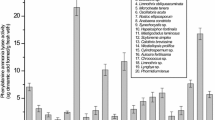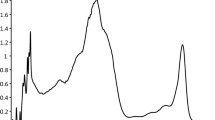Abstract
In the present study, ethanolic extracts of ten cyanobacterial strains cultivated under different nitrogen conditions were assessed for the phenolic content and antioxidant activity. The amount of detected phenolic compounds ranged from 14.86 to 701.69 μg g−1 dry weight (dw) and HPLC-MS/MS analysis revealed gallic acid, chlorogenic acid, quinic acid, catechin, epicatechin, kaempferol, rutin and apiin. Only catechin, among the detected phenolics, was present in all the tested strains, while quinic acid was the most dominant compound in all the tested Nostoc strains. The results also indicated the possibility of increasing the phenolic content in cyanobacterial biomass by manipulating nitrogen conditions, such as in the case of quinic acid in Nostoc 2S7B from 70.83 to 594.43 μg g−1 dw. The highest radical scavenging activity in DPPH assay expressed Nostoc LC1B with IC50 value of 0.04 ± 0.01 mg mL−1, while Nostoc 2S3B with IC50 = 9.47 ± 3.61 mg mL−1 was the least potent. Furthermore, the reducing power determined by FRAP assay ranged from 8.36 ± 0.08 to 21.01 ± 1.66 mg AAE g−1, and it was significantly different among the tested genera. The Arthrospira strains exhibited the highest activity, which in the case of Arthrospira S1 was approximately twofold higher in comparison to those in nitrogen-fixing strains. In addition to this, statistical analysis has indicated that detected phenolics were not major contributor to antioxidant capacities of tested cyanobacteria. However, this study highlights cyanobacteria of the genera Nostoc, Anabaena, and Arthrospira as producers of antioxidants and phenolics with pharmacological and health-beneficial effects, i.e., quinic acid and catechin in particular.


Similar content being viewed by others
References
Abd El-Aty AM, Mohamed AA, Samhan FA (2014) In vitro antioxidant and antibacterial activities of two fresh water cyanobacterial species, Oscillatoria agardhii and Anabaena sphaerica. J Appl Pharm Sci 4:69–75
Abd El-Baky HH, El Baz FK, El-Baroty GS (2009) Production of phenolic compounds from Spirulina maxima microalgae and its protective effects. Afr J Biotechnol 8:7059–7067
Agyei D, Danquah MK, Sarethy IP, Pan S (2015) Antioxidative peptides derived from food proteins. In: Rani V, Yadav U (eds) Free radicals in human health and disease. Springer, New Delhi, pp 417–430
Al-Hazzani AA, Alshatwi AA (2011) Catechin hydrate inhibits proliferation and mediates apoptosis of SiHa human cervical cancer cells. Food Chem Toxicol 49:3281–3286
Al-Rashed SA, Ibrahim MM, El-Gaaly GA, Al-Shehri S, Mostafa A (2016) Evaluation of radical scavenging system in two microalgae in response to interactive stresses of UV-B radiation and nitrogen starvation. Saudi J Biol Sci 23:706–712
Babaoğlu Aydaş S, Ozturk S, Aslım B (2013) Phenylalanine ammonia lyase (PAL) enzyme activity and antioxidant properties of some cyanobacteria isolates. Food Chem 136:164–169
Babić O, Kovač D, Rašeta M, Šibul F, Svirčev Z, Simeunović J (2016) Evaluation of antioxidant activity and phenolic profile of filamentous terrestrial cyanobacterial strains isolated from forest ecosystem. J Appl Phycol 28:2333–2342
Belay A (2013) Biology and industrial production of Arthrospira (Spirulina). In: Richmond A, Hu Q (eds) Handbook of microalgal culture: applied phycology and biotechnology. Blackwell, Oxford, pp 339–358
Benzie IFF, Strain JJ (1996) The ferric reducing ability of plasma (FRAP) as a measure of antioxidant power: the FRAP assay. Anal Biochem 239:70–76
Cepoi L, Rudi L, Miscu V, Cojocari A, Chiriac T, Sadovnic D (2009) Antioxidative activity of ethanol extracts from Spirulina platensis and Nostoc linckia measured by various methods. Analele Universităţii din Oradea, Fascicula Biologie 16:43–48
Chen AY, Chen YC (2013) A review of the dietary flavonoid, kaempferol on human health and cancer chemoprevention. Food Chem 138:2099–2107
Colla LM, Reinehr CO, Reichert C, Costa JAV (2007) Production of biomass and nutraceutical compounds by Spirulina platensis under different temperature and nitrogen regimes. Bioresour Technol 98:1489–1493
Čiž M, Čížová H, Denev P, Kratchanova M, Slavov A, Lojek A (2010) Different methods for control and comparison of the antioxidant properties of vegetables. Food Control 21:518–523
Espin JC, Soler-Rivas C, Wichers HJ (2000) Characterization of the total free radical scavenger capacity of vegetable oils and oil fractions using 2,2-diphenyl-1-picrylhydrazyl radical. J Agric Food Chem 48:648–656
Freile-Pelegrín Y, Robledo D (2013) Bioactive phenolic compounds from algae. In: Hernández-Ledesma B, Herrero M (eds) Bioactive compounds from marine foods: plant and animal sources. John Wiley & Sons, Chichester, pp 113–129
Goiris K, Muylaert K, Fraeye I, Foubert I, De Brabanter J, De Cooman L (2012) Antioxidant potential of microalgae in relation to their phenolic and carotenoid content. J Appl Phycol 24:1477–1486
Guedes AC, Amaro HM, Barbosa CR, Pereira RD, Malcata FX (2011) Fatty acid composition of several wild microalgae and cyanobacteria, with a focus on eicosapentaenoic, docosahexaenoic and α-linolenic acids for eventual dietary uses. Food Res Int 44:2721–2729
Guedes AC, Gião MS, Seabra R, Ferreira AC, Tamagnini P, Moradas-Ferreira P, Malcata FX (2013) Evaluation of the antioxidant activity of cell extracts from microalgae. Mar Drugs 11:1256–1270
Hajimahmoodi M, Faramarzi MA, Mohammadi N, Soltani N, Oveisi MR, Nafissi-Varcheh N (2010) Evaluation of antioxidant properties and total phenolic contents of some strains of microalgae. J Appl Phycol 22:43–50
Ijaz S, Hasnain S (2016) Antioxidant potential of indigenous cyanobacterial strains in relation with their phenolic and flavonoid contents. Nat Prod Res 30:1297–1300
Jerez-Martel I, García-Poza S, Rodríguez-Martel G, Rico M, Afonso-Olivares C, Gómez-Pinchetti J (2017) Phenolic profile and antioxidant activity of crude extracts from microalgae and cyanobacteria strains. J Food Qual 4:1–8
Kepekçi RA, Saygideger SD (2012) Enhancement of phenolic compound production in Spirulina platensis by two-step batch mode cultivation. J Appl Phycol 24:897–905
Lefort EC, Blay J (2013) Apigenin and its impact on gastrointestinal cancers. Mol Nutr Food Res 57:126–144
Li H-B, Cheng K-W, Wong C-C, Fan K-W, Chen F, Jiang Y (2007) Evaluation of antioxidant capacity and total phenolic content of different fractions of selected microalgae. Food Chem 102:771–776
Li P, Jia J, Zhang D, Xie J, Xu X, Wei D (2014) In vitro and in vivo antioxidant activities of a flavonoid isolated from celery (Apium graveolens L. var. dulce). Food Funct 5:50–56
Ma R, Lu F, Bi Y, Hu Z (2015) Effects of light intensity and quality on phycobiliprotein accumulation in the cyanobacterium Nostoc sphaeroides Kützing. Biotechnol Lett 37:1663–1669
Machu L, Misurcova L, Ambrozova JV, Orsavova J, Mlcek J, Sochor J, Jurikova T (2015) Phenolic content and antioxidant capacity in algal food products. Molecules 20:1118–1133
Milovanović I, Mišan A, Simeunović J, Kovač D, Jambrec D, Mandić A (2015) Determination of volatile organic compounds in selected strains of cyanobacteria. J Chem. https://doi.org/10.1155/2015/969542
Miranda MS, Cintra RG, Barros SBM, Mancini-Filho J (1998) Antioxidant activity of the microalga Spirulina maxima. Braz J Med Biol Res 31:1075–1079
Mukund S, Sivasubramanian V, Palanisamy M, Chinnu K (2014) In vitro antioxidant and anti-proliferative activity of Phormidium fragile. J Algal Biomass Utln 5:49–57
Müller L, Fröhlich K, Böhm V (2011) Comparative antioxidant activities of carotenoids measured by ferric reducing antioxidant power (FRAP), ABTS bleaching assay (αTEAC), DPPH assay and peroxyl radical scavenging assay. Food Chem 129:139–148
Nunnery JK, Mevers E, Gerwick WH (2010) Biologically active secondary metabolites from marine cyanobacteria. Curr Opin Biotechnol 21:787–793
Ogawa T, Terui G (1970) Studies on the growth of Spirulina platensis: (I) On the pure culture of Spirulina platensis. J Ferment Tech 48:361–367
Onofrejová L, Vašíčková J, Klejdus B, Stratil P, Mišurcová L, Kráčmar S, Kopecký J, Vacek J (2010) Bioactive phenols in algae: the application of pressurized-liquid and solid-phase extraction techniques. J Pharm Biomed 51:464–470
Orčić D, Francišković M, Bekvalac K, Svirčev E, Beara I, Lesjak M, Mimica-Dukić N (2014) Quantitative determination of plant phenolics in Urtica dioica extracts by high-performance liquid chromatography coupled with tandem mass spectrometric detection. Food Chem 143:48–53
Pero RW, Lund H (2009) In vivo treatment of humans with quinic acid enhances DNA repair and reduces the influence of lifestyle factors on risk to disease. Int J Biotechnol Biochem 5:293–305
Ramalho SA, Gualberto NC, Santos Leite Neta MT, Batista RA, Araújo SM, Moreira J, Narain N (2014) Catechin and epicatechin contents in wines obtained from Brazilian exotic tropical fruits. Food Nutr Sci 5:449–457
Rippka R, Deruelles J, Waterbury JB, Herdman M, Stanier RY (1979) Generic assignments, strain histories and properties of pure cultures of cyanobacteria. J Gen Microbiol 111:1–61
Rodriguez-Garcia I, Guil-Guerrero JL (2008) Evaluation of the antioxidant activity of three microalgal species for use as dietary supplements and in the preservation of foods. Food Chem 108:1023–1026
Rop O, Mlcek J, Jurikova T, Neugebauerova J, Vabkova J (2012) Edible flowers—a new promising source of mineral elements in human nutrition. Molecules 17:6672–6683
Safafar H, van Wagenen J, Møller P, Jacobsen C (2015) Carotenoids, phenolic compounds and tocopherols contribute to the antioxidative properties of some microalgae species grown on industrial wastewater. Mar Drugs 13:7339–7356
Sakač MB, Sedej IJ, Mandić AI, Mišan AČ (2015) Antioksidativna svojstva brašna od heljde –doprinos funkcionalnosti pekarskih, testeničarskih i brašneno-konditorskih proizvoda. Hemijska industrija 69:469–483
Shalaby EA, Shanab SMM (2013) Comparison of DPPH and ABTS assays for determining antioxidant potential of water and methanol extracts of Spirulina platensis. Indian J Geomarine Sci 42:556–564
Sharathchandra K, Rajashekhar M (2013) Antioxidant activity in the four species of cyanobacteria isolated from a sulfur spring in the western ghats of Karnataka. Int J Pharm Bio Sci 4:275–285
Simeunović J, Bešlin K, Svirčev Z, Kovač D, Babić O (2013) Impact of nitrogen and drought on phycobiliprotein content in terrestrial cyanobacterial strains. J Appl Phycol 25:597–607
Suhail S, Biswas D, Farooqui A, Arif JM, Zeeshan M (2011) Antibacterial and free radical scavenging potential of some cyanobacterial strains and their growth characteristics. J Chem Pharm Res 3:472–478
Tanwar B, Modgil R (2012) Flavonoids: dietary occurrence and health benefits. Spatula DD 2:59–68
Vaz JA, Heleno SA, Martins A, Almeida GM, Vasconcelos MH, Ferreira IC (2010) Wild mushrooms Clitocybe alexandri and Lepista inversa: in vitro antioxidant activity and growth inhibition of human tumour cell lines. Food Chem Toxicol 48:2881–2884
Yu H, Jia S, Dai Y (2009) Growth characteristics of the cyanobacterium Nostoc flagelliforme in photoautotrophic, mixotrophic and heterotrophic cultivation. J Appl Phycol 21:127–133
Funding
This study has been supported by the funding of the Ministry of Education, Science and Technological Development, Republic of Serbia (project number: TR 31029) which is greatly acknowledged.
Author information
Authors and Affiliations
Corresponding author
Rights and permissions
About this article
Cite this article
Blagojević, D., Babić, O., Rašeta, M. et al. Antioxidant activity and phenolic profile in filamentous cyanobacteria: the impact of nitrogen. J Appl Phycol 30, 2337–2346 (2018). https://doi.org/10.1007/s10811-018-1476-4
Received:
Revised:
Accepted:
Published:
Issue Date:
DOI: https://doi.org/10.1007/s10811-018-1476-4




